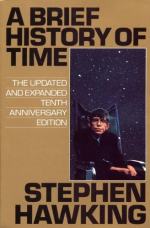
|
| Name: _________________________ | Period: ___________________ |
This test consists of 15 multiple choice questions and 5 short answer questions.
Multiple Choice Questions
1. What does the P stand for in combinations of operations?
(a) The mirror image.
(b) The positve of a negative.
(c) The particular charge of a particle.
(d) The place a particle holds.
2. Hawking argues that randomness must exist to a certain degree due to what?
(a) The uncertainty principle.
(b) The theory of relativity.
(c) The lack of knowledge.
(d) The ability to run time backwards.
3. What force is the weakest of the four categories of forces?
(a) Light.
(b) Attraction.
(c) Gravity.
(d) Energy.
4. How many questions are left unanswered prior to the development of math that incorporates quantum mechanics?
(a) Three.
(b) Five.
(c) Four.
(d) Six.
5. Hawking's model of the universe says the universe will end how?
(a) It will end because all matter will disappear.
(b) It will never end.
(c) It will end because black holes will suck all matter in.
(d) It will end in a big explosion.
6. Galileo was in constant conflict with what church?
(a) Baptist.
(b) Catholic.
(c) Presbyterian.
(d) Christian.
7. What might escape from a black hole?
(a) Gamma rays.
(b) Photons.
(c) Nothing.
(d) Something with more gravitational force than a black hole.
8. Galileo belied that the earth did what?
(a) Orbited the sun.
(b) Was the center of the solar system.
(c) Held still while everything rotated around it.
(d) Was the center of the universe.
9. In what year was Einstein's vocal support of the Zionist cause recognized?
(a) 1950.
(b) 1951.
(c) 1949.
(d) 1952.
10. Galileo wrote about Copernicus' theory in which language?
(a) Latin.
(b) Greek.
(c) French.
(d) Italian.
11. To illustrate the concept of disorder in a system, Hawking uses what example in Chapter 9?
(a) A car crash.
(b) A bag of marbles.
(c) A broken vase.
(d) A jigsaw puzzle.
12. Which of the following is not an arrow of time recognized by Hawking's book?
(a) Physiological.
(b) Thermodynamic.
(c) Cosmological.
(d) Psychological.
13. The man who was convicted of trying to murder Einstein was fined how much?
(a) One hundred dollars.
(b) He wasn't fined at all.
(c) He was thrown in jail, not fined.
(d) Six dollars.
14. Gravitational force is always what?
(a) Attractive.
(b) Present.
(c) Repulsive.
(d) Negated by other forces.
15. A closed string is defined as what?
(a) A string that closes off an area of space.
(b) A string that has ends.
(c) A string joined up with itself in a closed loop.
(d) A string that connects two objects and no other.
Short Answer Questions
1. The laws of science that govern the behavior of matter under all normal situations say that under the combination of the two operations C and P, what happens?
2. What book did Galileo publish, with the backing of the church's censors?
3. Hawking believes that scientists are too taken up with the "what" of the universe to ask which question?
4. Some particles might match up with their anti-particles at what point?
5. Infinities in partial theories can be canceled out through a process known as what?
|
This section contains 508 words (approx. 2 pages at 300 words per page) |

|




